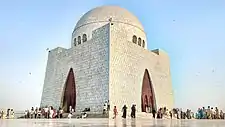
The economy of Sindh is the 2nd largest of all the provinces in Pakistan. Much of Sindh's economy is influenced by the economy of Karachi, the largest city and economic capital of the country. Historically, Sindh's contribution to Pakistan's GDP has been between 30% and 32.7%. Its share in the service sector has ranged from 21% to 27.8% and in the agriculture sector from 21.4% to 27.7%. Performance-wise, its best sector is the manufacturing sector, where its share has ranged from 36.7% to 46.5%.[1] Since 1972, Sindh's GDP has expanded by 3.6 times.[2]

Endowed with coastal access, Sindh is a major centre of economic activity in Pakistan and has a highly diversified economy ranging from heavy industry and finance centred in and around Karachi to a substantial agricultural base along the Indus. Manufacturing includes machine products, cement, plastics, and various other goods.
Agriculture plays an important role in Sindh with cotton, rice, wheat, sugar cane, bananas, and mangoes as the most important crops. The largest and finer quality of rice is produced in Larkano district.[3][4]
Sindh is the richest province in natural resources of gas, petrol, and coal. The Mari Gas field is the biggest producer of natural gas in the country, with companies like Mari Petroleum.[5] Thar coalfield also includes a large lignite deposit.[5]
Tourism
Sindh is a province in Pakistan.
The province includes a number of important historical sites. The Indus Valley civilization (IVC) was a Bronze Age civilization (mature period 2600–1900 BCE) which was centred mostly in the Sindh.[6]Sindh has numerous tourist sites with the most prominent being the ruins of Mohenjo-daro near the city of Larkana.[6] Islamic architecture is quite prominent as well as colonial and post-partition sites. Additionally natural sites, like Manchar Lake have increasingly been a source of sustainable tourism in the province.[7]See also
References
- ↑ "Provincial Accounts of Pakistan: Methodology and Estimates 1973-2000" (PDF).
- ↑ http://siteresources.worldbank.org/PAKISTANEXTN/Resources/293051-1241610364594/6097548-1257441952102/balochistaneconomicreportvol2.pdf
- ↑ Gazetteer of the Province of Sind …. government at the "Mercantile" steam Press. 1907.
- ↑ "About Sindh". Consulate General of the People's Republic of China in Karachi. Retrieved 15 December 2016.
- 1 2 "Pakistan: Mining, Minerals and Fuel Resources". AZoMining.com. 2012-09-15. Retrieved 2021-10-04.
- 1 2 "Tourism in Sindh - The Express Tribune". 22 November 2013.
- ↑ Mangan, Tehmina; Brouwer, Roy; Lohano, Heman Das; Nangraj, Ghulam Mustafa (2013-04-01). "Estimating the recreational value of Pakistan's largest freshwater lake to support sustainable tourism management using a travel cost model". Journal of Sustainable Tourism. 21 (3): 473–486. doi:10.1080/09669582.2012.708040. ISSN 0966-9582.
